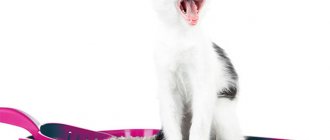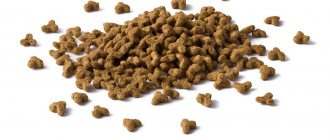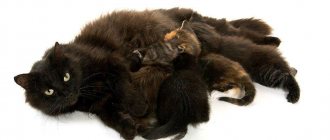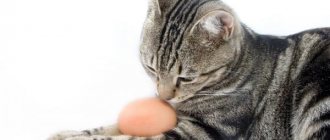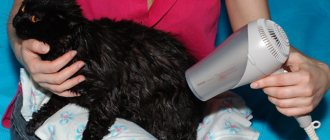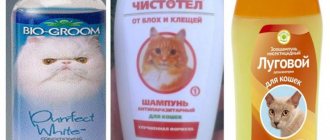Constipation in a cat (coprostasis) is not at all uncommon - this misfortune happens to a cute pet quite often if there are disturbances in the maintenance and lifestyle of the animal. You should study why the cat is suffering from this phenomenon, how to help it and prevent the situation from worsening. Probably, knowing the cause and eliminating it, we will thereby make life easier for the cat and ourselves. So, all about feline constipation and its treatment.
How often should your pet go to the toilet?
global $ads_google; //data-ad-slot=”2475549904″ $ads_google = empty($ads_google) ? false : true; ?> if ($ads_google == false) {?>
$ads_google = true; ?> } ?>
Defecation in adult cats should occur regularly, on average this is 1 act per 1 day, maximum per 1.5 days. The feces must look dense and formed. But with constipation, the stool looks different, the feces are hard, cracked, or resemble pea-shaped goat feces. It happens that mucus or blood is noticeable in the stool, especially if it is noticed that the cat goes to the tray, meowing in pain.
If the frequency of bowel movements has become less frequent, and the cat does not leave a “gift” in the tray for 2-3 days in a row, constipation may be suspected. In this case, at first a good appetite remains, but then the state changes to depressed.
Lactusan for renal failure
In case of renal failure, the doctor’s goal is to prevent the processes of putrefaction in the animal’s intestines, since putrefaction contributes to the stagnation of ammonia in the body. Lactusan is the most suitable drug for this purpose. It helps reduce ammonia in the gastrointestinal tract and ensures normal microflora. Lactusan cleanses the blood and actively removes toxins and waste from the body through the intestines. As a result, creatinine and urea, the level of which is increased in chronic renal failure, decreases. Supports vital kidney functions. It is better to buy Lactusan for pussy in the form of a suspension. In this form, the medicine is easier to administer into the body.
Lactusan is prescribed by a veterinarian, together with other drugs. The dosage for chronic renal failure is 2-3 milliliters per dose.
Along with the drug, it is important to provide the pussy with a diet: reduce meat and protein products in food, give more water.
Main causes of constipation
There are several causes of constipation, we study them and consistently eliminate them one by one. This is the first step towards healing your cat.
Wool
The longer a cat's fur, the more problems this will cause. A particularly common cause of constipation can be ingestion of fur - the pet does not always manage to empty the stomach of the hairball, but it moves into the intestines and creates a blockage there. To ensure that this is no longer a cause of constipation, the animal should be regularly given holistic supplements that promote smooth removal of fur from the body.
Foreign body or parasites
The frequency of bowel movements may be affected by an accidental ingestion of a foreign body or the accumulation of parasites. Helminths quickly multiply and grow, contributing to the closure of the intestinal lumen. The situation is not at all safe and is fraught with the risk that sooner or later volvulus and rupture of the intestines will occur. In addition, throughout the life of the parasites, a very large amount of toxins are released into the blood, poisoning the animal.
Stress
Stressful situations definitely leave their mark on a cat’s soul, and at the same time they are projected onto its health. Even an insufficiently clean litter box can greatly upset a pet, not to mention aggression from other animals in the house or family members.
Abdominal surgery is also stressful, which can cause problems with stool.
Diseases
Diseases, both chronic and infectious, can lead to problems with the bile ducts. The importance of bile in the processing of fats and a number of other functions, therefore, a decrease in its supply or complete cessation is fraught with serious digestive disorders. This leads to impaired intestinal motility and coprostasis.
An intestinal tumor can lead to complete blockage of the intestinal lumen; delay in contacting a veterinarian will lead to death.
Constipation after sterilization
global $ads_google; //data-ad-slot=”2475549904″ $ads_google = empty($ads_google) ? false : true; ?> if ($ads_google == false) {?>
$ads_google = true; ?> } ?>
Sterilization often causes temporary intestinal dysfunction, because it is an operation with the introduction of anesthesia. Your cat's constipation should go away within a few days after this. If there is no improvement within a week, then the owner should take the cat to a veterinary hospital for examination: after the operation, adhesions could form, and this can only be solved surgically.
Diet errors
If a cat eats something it is not supposed to eat, the owner can expect problems. It’s not for nothing that nutritional standards for pets have been developed, and if mustaches can’t eat chicken and fish bones, then so be it. River fish is also prohibited - in addition to the possibility of becoming infected with helminths, the cat has a chance of getting a puncture of the intestines with bones, and this is not constipation, but peritonitis.
Excessive consumption of dry food and a small amount of water lead to dehydration of feces, which are then difficult to remove from the body. It makes sense to reconsider your view on the diet of your beloved cat.
What symptoms appear?
An animal with this problem may also suffer from bloating.
Constipation in a one-month-old kitten or an older baby is always accompanied by restless behavior of the animal. The kitten meows loudly and refuses to eat. On palpation, the abdomen is hard, swollen, filled with gases. The cat may often squat down to poop, but nothing comes out, or during defecation, a foul-smelling green slurry is released instead of feces. If you still managed to squeeze out feces, then in appearance it resembles dry peas. With such symptoms, cats require urgent medical attention; untimely treatment leads to general intoxication of the body and even the death of the baby.
Symptoms and signs of constipation in a cat
Coprostasis at home is not difficult to determine, if only by the fact that when defecating, the cat makes sounds that are defined as a signal of pain. Feces come out in tiny or small portions, often in thin strings or firm lumps. Let's look at all the symptoms of constipation.
If stool that resembles ribbons or flagella comes out of the anus, this is a likely indicator of the presence of a body or formation in the intestine that is interfering with the movement of feces.
Gradually, a depression in the general condition of the animal will be noticeable, with the inability to empty the intestines, loss of appetite, and signs of severe intoxication. The pet's belly looks bloated and feels hard to the touch.
An accompanying symptom may be vomiting, which will be a signal of intestinal obstruction.
Further development of events without treatment is fraught with seizures and coma. It is best to seek help from a veterinarian.
When is papaverine used?
constipation: regulation of the physiological rhythm of colon emptying;
softening of stool for medical purposes (hemorrhoids, operations on the colon and anus);
hepatic encephalopathy - treatment and prevention of hepatic coma and precoma;
intestinal dysbiosis; enteritis caused by salmonella, shigella, salmonellosis in the stage of bacterial carriage; putrefactive dyspepsia syndrome (in young children as a result of acute food poisoning).
Treatment of defecation retention
Treatment of constipation in cats consists of finding out the root cause of this dangerous phenomenon, and then you can think about how and how to help your pet.
If the suspicion falls on intestinal obstruction, then drinking and force-feeding will simply lead to such consequences as intestinal rupture and peritonitis. The doctor will make an accurate diagnosis after palpation, x-ray or ultrasound.
After visiting the veterinarian, the owner will have a detailed treatment plan in his hands, unless, of course, surgical intervention is required. Each case is individual.
Let's consider the types of assistance that owners themselves can provide to their cat if the case is not so critical.
global $ads_google; //data-ad-slot=”2475549904″ $ads_google = empty($ads_google) ? false : true; ?> if ($ads_google == false) {?>
$ads_google = true; ?> } ?>
Laxatives
Among the laxatives that are used for sphincter spasms in the intestines or during narrowing of the intestinal lumen, you can purchase a substance in ampoules - magnesium sulfate. For cats, you need to take a dosage of 3 to 10 g per day.
A drug called sodium sulfate acts as an irritant to the intestinal walls, increases osmosis and allows water to accumulate. The expected effect time is 7-14 hours. Recommended dosage is 2-5 g.
Buckthorn bark in the convenient medicine Ramnil can be used for cats in a dosage of 0.5 tablets per day.
If constipation has already taken a chronic form and there is intestinal atony, then the animal should be given Izafenin. This drug becomes an irritant to intestinal receptors and helps improve the bowel movement process. The product is a powder and for an adult cat it is required to give from 1 to 5 mg per day. You can give the drug once or twice a day.
Here is a list of laxatives for constipation:
- Lactusan;
- Duphalac;
- Prelax;
- Vetelact;
- Guttalax.
Finding these laxatives is easy:
Enema
An enema is not the most pleasant procedure for a cat, and if there is constipation, it is very painful. To administer an enema, you need an assistant to securely fix the limbs and head. To carry out the procedure, you need to find a place convenient for fixation, usually a table. Prepare several liters of water at room temperature; you can replace it with a decoction of chamomile or flaxseed. The basin is positioned so that all feces fall into the water.
Take a baby bulb and lubricate its tip with Vaseline, draw in water and carefully insert it into the rectal opening. The liquid is squeezed out slowly. Afterwards, the pear is removed and the stomach is gently massaged. The contaminated water will begin to come out.
The manipulation is repeated until the feces are completely released. After the enema, the cat is supported with rectal anti-inflammatory suppositories.
Enema has a number of contraindications. You can't do it if:
- the owner knows for sure that the intestines can be damaged;
- blood flows from the anus;
- have diseases of the cardiovascular system;
- there is helminthiasis;
- during
pregnancy .
Vegetable oil
A loyal, but rather weak remedy for the treatment of constipation in cats. In this case, preference is given to olive, hemp or flaxseed oil. You can add it to food, but the cat himself is not averse to licking the oil off his fingers. Several hours pass, and after the first attempts the animal already goes to the toilet.
You cannot use the oil method every day, as this will have a very negative effect on the cat’s liver.
Vaseline or castor oil
A good way would be to use Vaseline or castor oil. The advantage is that they are not absorbed by the intestines, but penetrate into lumps of feces, which has a softening effect. Accordingly, peristalsis improves.
Oils are poured with a simple syringe without a needle. For the first time, up to 15 ml is administered, and after 4 hours another 5 ml. It is allowed to use the product up to 5 times a day, 5 ml every 4 hours.
Massage
global $ads_google; //data-ad-slot=”2475549904″ $ads_google = empty($ads_google) ? false : true; ?> if ($ads_google == false) {?>
$ads_google = true; ?> } ?>
Suffering cats can receive a gentle massage consisting of light pressure strictly clockwise. After waiting 15 minutes, the massage continues again. Not the fastest way, if you suspect intestinal volvulus, you should not massage your pet’s stomach; here you need the help of a qualified specialist.
Changing your diet
The first thing you need to understand: no matter how suffering and hungry a cat with coprostasis may seem, you cannot force feed it. If the animal still begs for food, then you can offer broth, and either soak the dry food or replace it with canned wet food.
There is a line of medicinal foods, you will learn about them below. First you need to solve problems with fecal output, and then think about buying such food.
If mistakes have been made in a cat’s diet and you need to change its diet, you cannot do this right away. Changes should happen smoothly and gradually, over a couple of weeks. It will be necessary to add a new type of food to the previous one and monitor the food reaction.
The water is always fresh and clean!
If your cat is a breed with long hair, you should consider adding holistic foods to its diet - they will prevent the hair from accumulating inside in clumps and thereby causing any type of digestive upset.
Phytotherapy
You can buy senna (cassia) leaves in a regular pharmacy. You only need 4-5 g, which are filled with hot water, given the size of the cat, you shouldn’t take a lot of water, 25 ml is enough.
The steamed raw materials are placed in a water bath for half an hour and cooled. After filtering, you can start feeding your pet.
This approach will help if the cat still, although with difficulty, goes to the toilet on its own.
Other methods
There is a folk method for this problem, but its effect is not strong, rather moderate.
A teaspoon of condensed milk is diluted with water and given to the patient to drink. You usually don’t have to ask; the cats themselves willingly lap up this product. But this method will not work if the cat is suspected of having diabetes.
The principle of action of laxatives
When constipated, your pet experiences pain in the intestinal area. With this disorder, contractions of the small and large intestines slow down, partially digested food accumulates and is retained for a long period of time. At this time, the mucous membranes located on the intestinal walls continue to absorb water, as a result of which the feces become overdried and hardened. The animal will not be able to empty its bowels on its own and will need laxatives.
Laxatives cause mechanical and chemical irritation of the gastrointestinal mucosa. As a result, the absorption of moisture in the intestines is disrupted, feces become more liquid and can easily leave the pet’s body.
Laxatives differ in how they act for certain symptoms.
- Drugs that cause chemical irritations in the intestines do not affect the body immediately, but after five hours. This type is used for isolated cases of constipation.
- Prebiotic medications are used for chronic and acute constipation. A gentle effect on the intestines will relieve constipation in just a couple of hours, but may cause diarrhea in the next day.
This type of medication is prohibited for pregnant, lactating and newborn pets. It is also not recommended to use it for longer than three months.
When is veterinary help needed?
global $ads_google; //data-ad-slot=”2475549904″ $ads_google = empty($ads_google) ? false : true; ?> if ($ads_google == false) {?>
$ads_google = true; ?> } ?>
It is not always possible to solve a problem at home and on your own. Cases vary, from intestinal blockage to adhesions or ruptured loops.
Even if the pet has eaten a large amount of boiled or raw bones or managed to swallow a foreign object, a laxative is not used. On the contrary, it can worsen the problem significantly.
A suffering animal needs to go to the veterinarian. The doctor will palpate the abdomen, if necessary, send for an x-ray and find the right solution.
You need to be prepared for the fact that surgery will be the solution.
What to do for prevention?
The owner who takes a four-legged baby into his home must understand that the health and proper development of the pet’s body depends on proper care and maintenance. If the kitten has ever had digestive problems and was bothered by constipation, after eliminating the disease, it is necessary to continue to constantly monitor so that this does not happen again.
As a preventive measure, veterinarians advise reviewing the animal’s diet and excluding from it foods that are prohibited for the cat’s body. It is best to switch your pet to ready-made food, which will help solve the problem of constipation. In addition, do not forget about drinking regime, physical activity, timely treatment of various diseases and scheduled preventive visits to the veterinarian.
Preventing constipation in cats
Having solved a problem once, it is better not to return to it. Seeing your beloved animal suffer every time and experiencing all the events with it is not easy: it is better to try to prevent coprostasis.
The first thing you need to consider in detail is the cat’s diet:
- more fiber in the form of bran and vegetables (if a natural diet is supported);
- it is necessary to switch to high-quality feed;
- Do not give your pet bones and cartilage;
- change the water in the bowl more often, you can buy a convenient drinking bowl;
- take a course of probiotics (10 days, once a day Bifitrilak 0.1).
In addition to the diet, you need to reconsider your approach to grooming your pet, especially if it has a lot of long hair. Brushing is carried out regularly, at the same time not forgetting to treat the kitty with pastes that will help remove the fur from the body.
The activity of cats also affects their stool: inactive creatures are more susceptible to constipation. You can activate your cat by involving him in the game.
The weight of a fluffy that is marked “excess” can also make it difficult to defecate.
It’s already clear about helminths: regular anthelmintic treatment according to schedule, along with vaccination, is mandatory.
The cleanliness of the litter box is a very important issue for many cats. They may refuse to visit such an unpleasant place, and this is a direct indication of the likelihood of constipation.
Reviews
Reviews for the medicine are positive:
- “I always keep lactusan in my medicine cabinet, it’s useful since it’s called a prebiotic.”
- “The cat was poisoned by anthelmintic and suffered from constipation for three days. On the advice of the veterinary forum, they gave Lactusan. It didn’t help immediately, but only after 6 hours. The cat began to have diarrhea, it seems that the dosage was followed.”
- “Removes toxins, normalizes microflora and stool, solves problems with the gastrointestinal tract, there are cheaper prebiotics, but Busya did not swallow them. And Lactusan, surprisingly, came in. And then they gave me the course without any problems.”
- “Someone tortures an animal by stuffing it with Vaseline oil, condensed milk, and soap solution for constipation. I shouldn't go to the vet, which is what I did. Lactusan, which was prescribed there, helped normally.”
Due to its slow action, Lactusan is not suitable for emergency use.
Preventive measures will solve the problem of constipation. By taking your cat to the veterinarian once a year, you will be able to recognize the disease at an early stage, which will determine further treatment.
When is a laxative necessary?
Having identified symptoms of constipation in a cat, you should not immediately give it laxatives, be it traditional or medicinal. Sometimes this is absolutely not worth doing.
Sometimes the absence of bowel movements is explained by psychological problems or stress. In such cases, laxatives are not needed. The animal must be calmed and a comfortable environment created.
In difficult cases, your pet should be examined by a veterinarian and undergo a course of treatment with antidepressants.
The cat may not accept the tray, the place where it is, or may not tolerate the filler for some reason. In such cases, the reason for the lack of defecation is also in a stressful state, and the animal needs help: change the type of litter, rearrange the tray, sometimes even buy another toilet.
If the cause of constipation is nutritional problems (prolonged fasting, switching to another food, inappropriate food), then the pet needs a diet.
You should consult your veterinarian on what to feed your cat. In such cases, folk remedies can be used for relief.
Medicines should not be given without a doctor’s prescription, especially if they are intended for humans. In some cases, you can use medications, for example, if the animal has undergone castration or sterilization surgery, the veterinarian will tell you about the appropriate ones.
If the cat does not go to the toilet for more than three days and experiences noticeable discomfort, it can also be helped with medication.
In other cases, if blood or mucous inclusions are found in the pet’s stool, then no medications should be given. There is also no need to give a laxative if constipation is caused by intestinal obstruction due to a foreign body.
In such cases, you can do an enema; this method will help to quickly cleanse the rectum and slightly alleviate the cat’s condition. However, you need to show the animal to a doctor as soon as possible.
Contraindications for use at home
A number of laxative drugs for cats allows you to choose a medicine individually for each pet. The mild effect of the drugs is not an obstacle to use even by small kittens, pregnant and lactating cats. General contraindications are: intestinal obstruction and individual intolerance to the components of the drug.
Timely detection of symptoms of constipation in a cat will make it easier to treat your pet. A consultation with a veterinarian will help ensure the correct dosage of medications and will also help determine the cause of the cat’s illness. And the correct selection of medicine will improve the pet’s well-being in a short time and lift the mood of the pet owner.
Cats, like humans, also suffer from constipation. A story about one of the laxatives - lactusan for cats. How to use it and is it suitable for everyone?
A wonderful prebiotic medicine that can gently and delicately solve the cat litter problem. Constipation occurs depending on many factors, for example, poor or unhealthy diet, lack of fiber, protein or insufficient fluid. The consequence is that bone tissue is poorly digested and the stomach becomes clogged.
Dosage
If you decide to give Duphalac to your cat for constipation without a veterinarian's prescription, you should start taking the drug with the minimum dosage. For an adult animal, the minimum dose is calculated from the ratio of 0.5 ml per 1 kg of weight. It is not recommended to give a kitten more than 0.5 ml at a time.
If after the first dose the animal does not experience any side effects or allergic reactions, drinking the suspensions is repeated two to three times a day with constant monitoring of changes in the cat’s well-being.
In most cases, Duphalac quickly and gently relieves a cat from constipation . However, you should be careful in dosages, since excessive use of the drug can lead to the development of diarrhea, and as a result, dehydration.
